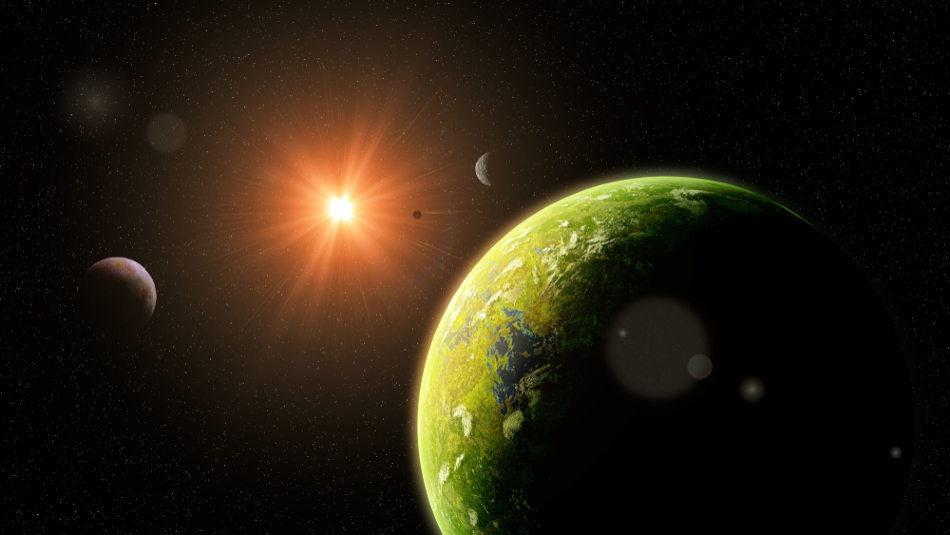
Image Credit: Dotted Yeti/Shutterstock.com
Astronomers have discovered that WASP-76b, an exoplanet 390 light-years from our own solar system, is a world dominated by an extreme dichotomy. One side is perpetually scorched by radiation from its star, while the other exists in permanent night and is battered by iron that rains from the sky.
An international team of astronomers, led by researchers from the University of Geneva has discovered that the distant exoplanet WASP-76b possesses a violent environment that is starkly divided into two distinct halves.
On the light side of the exoplanet, temperatures soar to a searing 2500⁰C, which is hot enough to cause molecules to break down into their constituent atoms. On the dark side, temperatures are 1000 ⁰C cooler, and droplets of iron rain down from the skies.
The astronomers were able to deduce the presence of this extraordinary disparity between the two sides of WASP-76b using the Echelle Spectrograph for Rocky Exoplanets and Stable Spectroscopic Observations (ESPRESSO) – an instrument connected to the European Southern Observatory’s (ESO) Very Large Telescope array, in the Atacama Desert, Chile.
Spectroscopic data from ESPRESSO revealed the signature of iron vapor in the exoplanet’s atmosphere, but only on one side of the planet. This led the team to conclude that as this vapor reaches the cooler side of the world, it condenses, forming droplets and falling to the surface in what they describe as ‘iron rain.’
The team’s research is published in the journal Nature.
What are Hot Jupiters?
The conditions and temperatures found by the astronomers are caused by WASP-76b’s unique relationship with its parent star.
WASP-76b is a member of a population of bodies referred to as ‘hot Jupiters’. These are gas giants similar to Jupiter, but occupying an orbit that brings them closer to their host star. This proximity sends their surface-atmosphere temperatures soaring. WASP-76b is so close to its star, that it completes its journey around the body in just 1.8 Earth days.
WASP-76b is also tidally locked to its star. This means that the same side of the planet faces the star at all times, in much the same way as the moon is tidally locked to the Earth.
For this world, that results in one side being perpetually bombarded with extreme radiation (roughly a 1,000 times amount received by Earth from our Sun) driving the temperatures to extremes that can disassociate even iron into its constituent atoms.
Conversely, the other side of the planet is in a state of constant night, allowing the temperatures to plunge to a temperature where the iron once again condenses. Unsurprisingly, the difference in relation to the star has led the researchers to label WASP-76b’s sides ‘dayside’ and ‘nightside’, respectively. This vast gulf in temperature between ‘day and night’ has another role in facilitating the exoplanet’s iron rains: driving the powerful winds which carry iron vapor from the dayside to the nightside.
Extending comparisons between WASP-76b and other exoplanets, the WASP-76 system is similar in many ways to 51-Pegasi, home of the first exoplanet observed by astronomers. Primary amongst these similarities is the fact that both systems comprise a star orbited at an extremely close-distance by a single gas-giant. Nor does this represent the first time astronomers have discovered such phenomena on an exoplanet — gaseous iron has been spotted in the atmospheres of other worlds.
There is something that makes WASP-76b unique within the exoplanet catalog, however, the stark divide between the planet’s day and night sides is something astronomers have never before observed. In addition to this, these findings represent the first time such an extreme chemical gradient has been measured across the surface of an exoplanet.
The team’s research has also delivered a surprise that may have important ramifications for the future of exoplanet hunting: Not only was this the first result delivered by the ESPRESSO instrument, it was also performing a function it was not originally designed to.
ESPRESSO’s primary mission is the discovery of rocky exoplanets similar to Earth. So far, such planets have been much harder for astronomers to spot than gas giants like WASP-76b, because they tend to be smaller, fainter, and closer to their parent star.
Exploring Exoplanet Atmospheres
ESPRESSO operates by breaking down light signatures from a star into its constituent spectrum. This method can also be applied to analyzing exoplanet atmosphere. Therefore, these findings from ESPRESSO have delivered astronomers a whole new way to examine the chemical make-up of exoplanets.
The research also confirms the conclusion that many astronomers have reached from exploring exoplanets: the universe is a far more exciting and dynamic place than we previously believed, and filled with worlds full of extraordinary phenomena.
References and Further Reading
- Ehrenreich. D, Lovis. C, Allart. R, et al, ‘Nightside condensation of iron in an ultrahot giant exoplanet,’ Nature, (2020), DOI: 10.1038/s41586–020–2107–1
Disclaimer: The views expressed here are those of the author expressed in their private capacity and do not necessarily represent the views of AZoM.com Limited T/A AZoNetwork the owner and operator of this website. This disclaimer forms part of the Terms and conditions of use of this website.